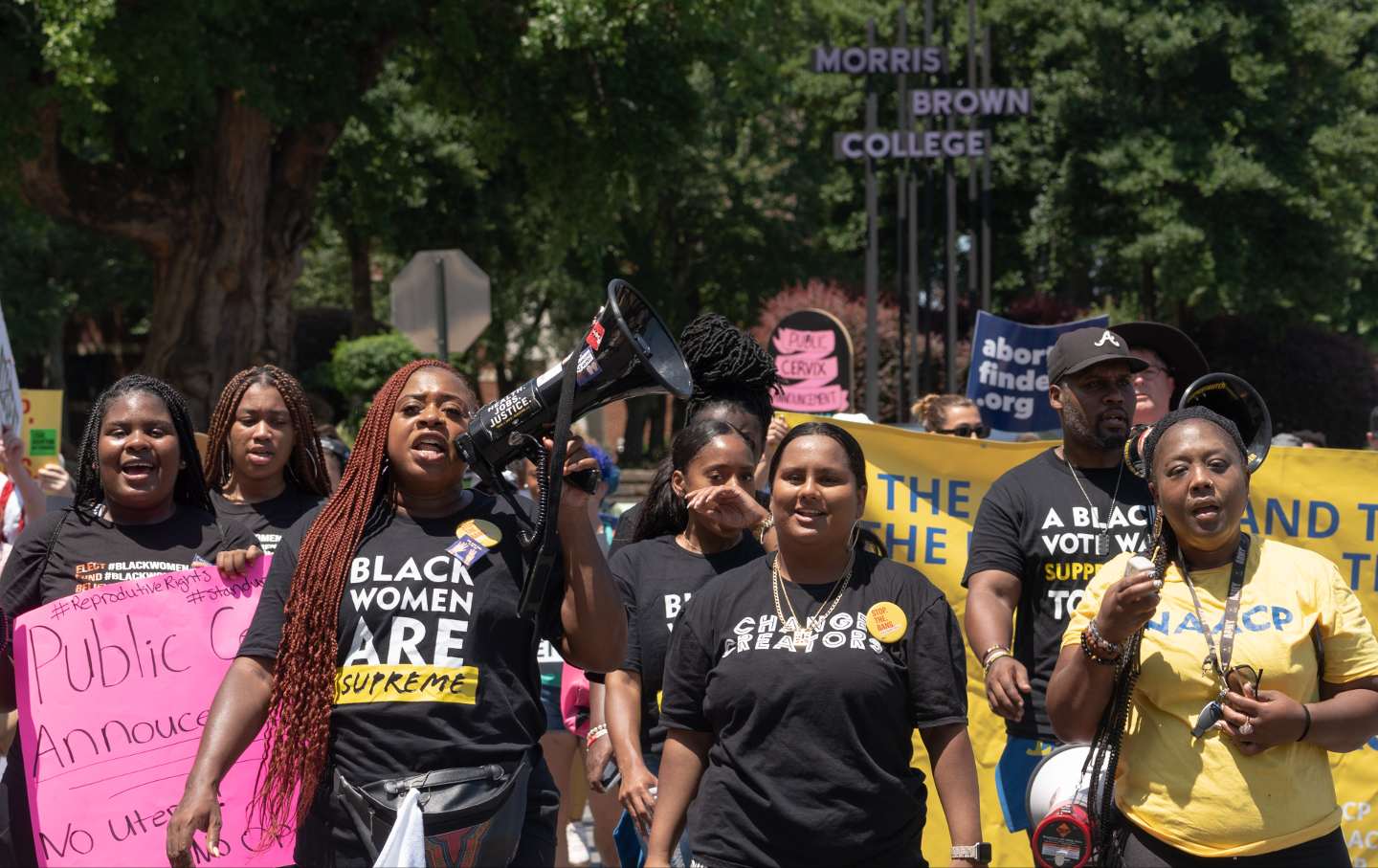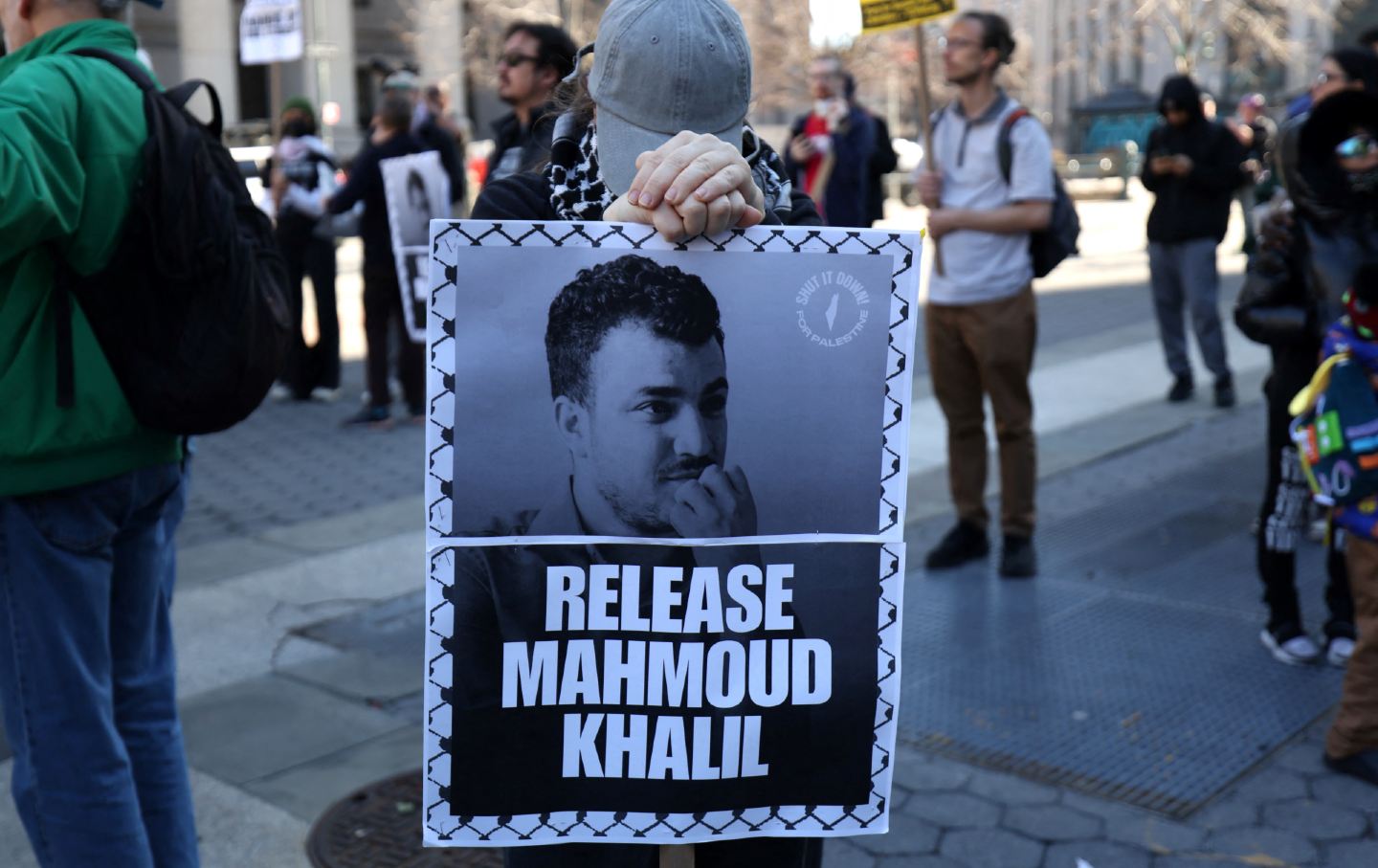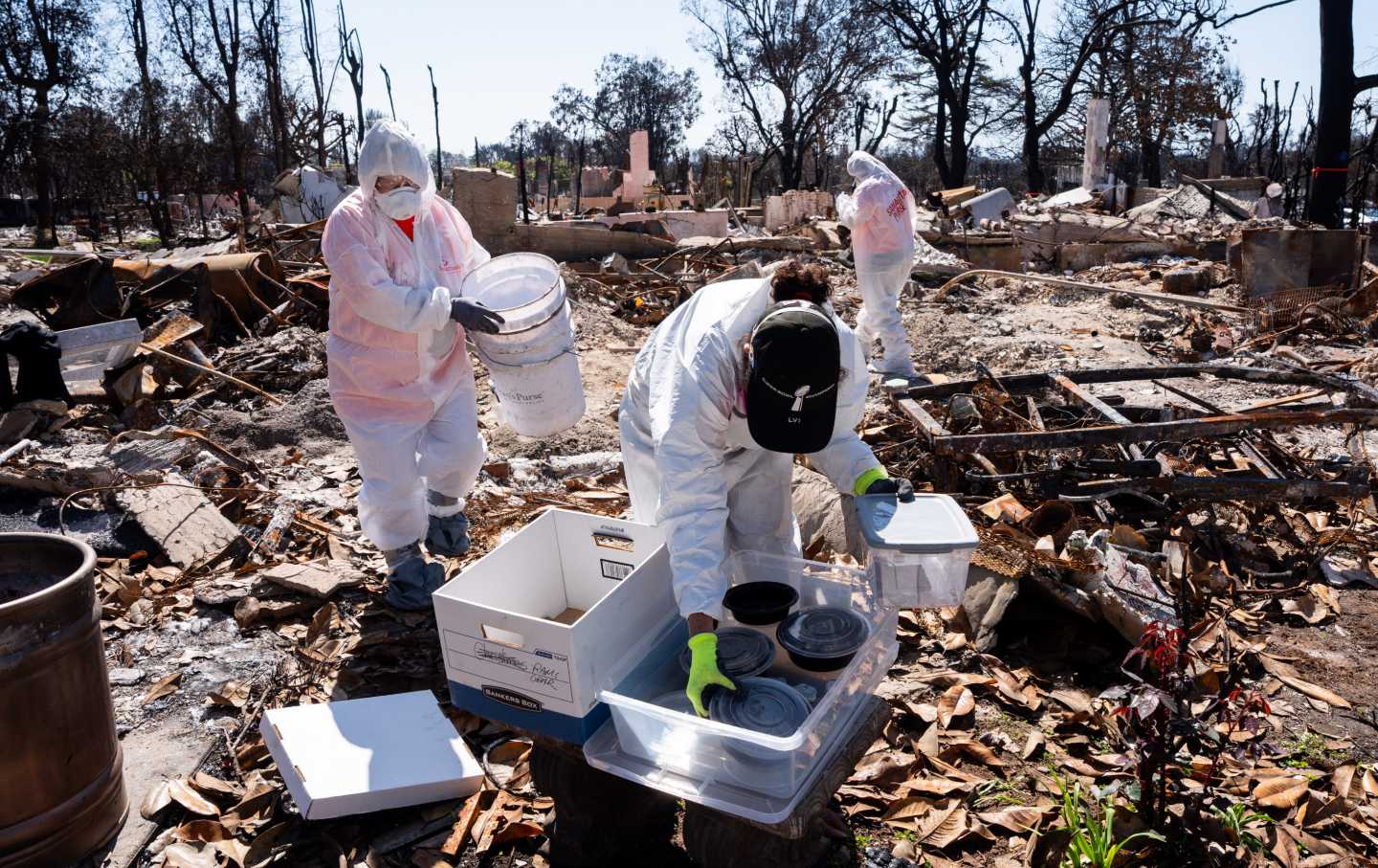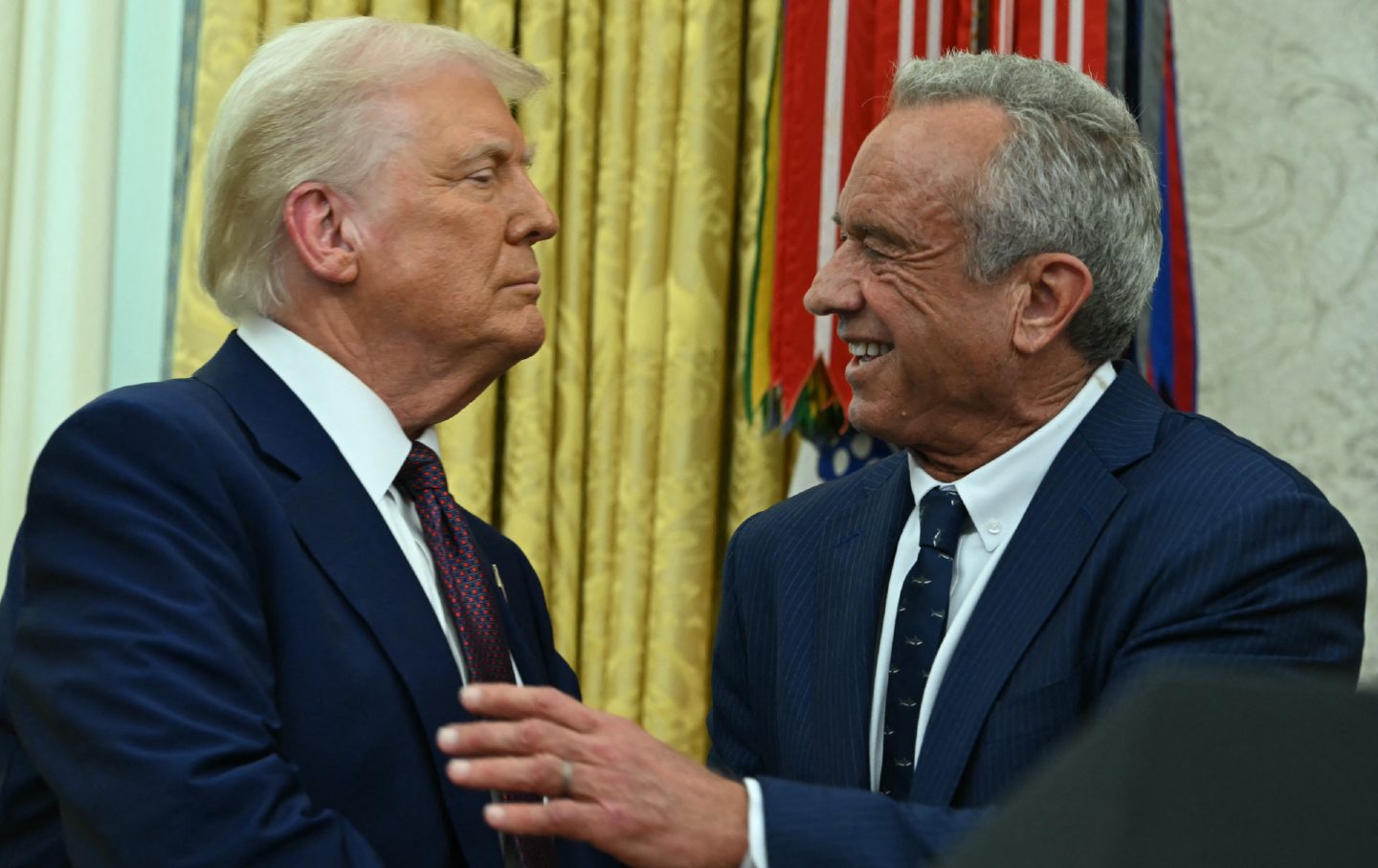An Abortion Ban Killed Amber Thurman—and Likely Many More
Will the law that killed this vibrant young woman, a mother and medical assistant, be allowed to stand?

Protesters march in downtown Atlanta in July 2022 in opposition to Georgia’s post-Dobbs abortion ban.
(Megan Varner / Getty Images)
Since the Supreme Court overturned Roe two years ago, many of us have been holding our breaths, waiting for our dead woman.
Now we know her name.
It’s Amber Nicole Thurman.
She was 28 and worked as a medical assistant and had a 6-year-old son whom she loved to take to petting zoos and the beach. As was horribly predictable, in a country where Black women seek abortions at higher rates and die far more commonly from maternal-health complications, she was Black. She died because doctors in Georgia did not perform a routine procedure to remove tissue retained after a medication abortion. She had wanted a procedural abortion in Georgia, but was forced by the state’s six-week ban to travel four hours away to North Carolina, where she missed her appointment because of standstill traffic. The clinic offered her a medication abortion instead; at nine weeks, she was well within the standard of care for that treatment. The complication she suffered is rare and can be treated with a routine procedure. She died because her home state of Georgia had made that routine procedure a felony.
Now her son is starting a new school year without her.
Related Article
ProPublica reported Thurman’s death Monday. It’s the first confirmed case after Dobbs where an abortion ban killed a woman. What’s most striking to me, beyond the sheer tragedy of her death, is how much work it took to confirm it. Reporter Kavitha Surana combed through death records and coroners’ reports to find cases that seemed related to abortion access. She first reached out to Thurman’s loved ones a year ago. Eventually, she obtained a document where the state’s maternal mortality review committee spelled out in black and white that Thurman’s death was “preventable.” On Wednesday ProPublica reported on a second death from Georgia’s abortion ban—that of Candi Miller, who had been warned her health was so fragile that another pregnancy could kill her. In 2022, when she became pregnant, Miller ordered abortion medication online. She experienced the same rare complication as Thurman, but she was afraid to seek care because of the state’s abortion ban. Instead, she took painkillers and suffered at home, until her husband found her unresponsive in bed with her 3-year-old daughter by her side. Given what it took to confirm that these deaths resulted from a ban, as Surana writes, “There are almost certainly others.” How many deaths have we not heard about, because finding them requires such intensive reporting?
In January, The New Yorker’s Stephania Taladrid reported on a young woman from Texas who had died two weeks after Roe was overturned from pregnancy-related complications, asking, as the headline read: “Did an Abortion Ban Cost a Young Texas Woman Her Life?” It was hard to say for sure, although it seemed the answer was yes. Yeni Glick, an aspiring scientist and certified nursing aide, suffered from health conditions, including hypertension, diabetes, and a history of pulmonary edema, that made pregnancy riskier for her. Undoubtedly, these conditions were complicated by the fact that she couldn’t afford the needed medications and prenatal care, but, as Taladrid reported, when Glick’s health collapsed during an acute hypertensive episode, her providers never gave her the option of an abortion, and she died awaiting transfer to a larger hospital. Glick’s death involved larger, structural failures like poverty and lack of healthcare access, and doubtless, many of the post-Dobbs deaths we’ve all been expecting are like hers—not the result of any one policy. They are no less tragic because of that.
It is hard to isolate the death of a young woman of color from these compounding causes in a country with the highest maternal mortality rate in the developed world. It is rare that an official document turns up that declares a death “preventable.”
But in Amber Thurman’s case, it happened. Hers is a rare case of a death we can lay squarely at the feet of a particular law. The question now is whether her death will lead to change. Will she become a rallying cry, like Savita Halappanavar, whose death after she was denied an abortion while miscarrying helped bring about the repeal of Ireland’s nationwide abortion ban? Or, like dead women from eras of lost abortion rights past, will she haunt us like a ghost, reminding our country of its failures?
I’ve been digging into the deaths of women from abortion bans for a book on the history of the anti-abortion movement, and what I’ve found so far is that anti-abortion policies tend to endure even after they’ve been traced to a woman’s death.
In 1977, Rosie Jimenez died as a direct result of the Hyde Amendment, the ban on federal funding of abortion passed in 1976. A young mother and student in South Texas, she had had two abortions before the Hyde Amendment cut off her access under Medicaid. So she went to a midwife who performed an abortion in unsterile conditions, and she contracted a terrible infection. She suffered for days in agony and left behind a daughter who grew up without a mom. We only know these facts because of the reporting of the late feminist journalist Ellen Frankfort and abortion rights activist Frances Kissling, who traveled to McAllen, Texas, and spoke to the women who knew Rosie. If not for their reporting, Rosie may have been remembered as just another Latina who went across the border for an abortion out of shame, as a Washington Post article headlined “Doubts Arise About Abortion Martyr” put it. Like Surana at ProPublica, Kissling and Frankfort were able to draw a direct line between a woman’s death and the policy that killed her, which they ultimately documented in their book Rosie: The Investigation of a Wrongful Death.
The book is now out of print, and the Hyde Amendment is still law of the land. While efforts to repeal Hyde are finally gaining mainstream traction, we’ll never know how many more Rosies are out there whom we never learned about.
In 1988, Becky Bell died at the age of 17 as a direct result of Indiana’s parental consent law. When she discovered that she was pregnant, she went to Planned Parenthood, where she learned that to get an abortion she would need parental consent or a waiver from a judge. But the judge who would have considered Becky’s case was known to be anti-abortion. Fearing that she would disappoint her parents if she told them she was pregnant, Becky found a way to end the pregnancy without telling them. She died of pneumonia from an infection caused by unsterile instruments. We only know her story because her parents, an all-American couple who had been homecoming king and queen a year apart at the same high school, decided to go public with the secret their daughter took to her grave.
Today, Indiana is one of 14 states that ban abortion outright. We’ll never know how many more Beckys are out there whose names we never learned.
Will the policy that killed Amber Thurman be allowed to stand?
The answer depends in part on the election. Georgia is a key swing state where voting rights activists have been working overtime to combat voter suppression and keep the state blue. (Voters there narrowly chose Biden and sent two Democratic senators to Washington in 2020). Vice President Kamala Harris released a statement Monday that lay the blame for Thurman’s death on Trump, saying, “This young mother should be alive, raising her son, and pursuing her dream of attending nursing school,” and she has called attention many times to the threat abortion bans pose to pregnant people’s health and lives. But there’s more to do. If I were advising Harris, I’d tell her to hold a press conference in Thurman’s hometown with a photograph of this vibrant young woman and lay her death at the feet of Republican policymakers. Perhaps such an event would help bolster local Democrats in the state who could do something about the law that killed Amber Thurman.
“Reproductive Justice advocates have been sounding the alarm for years about abortion restrictions leading to worse maternal health and emergency reproductive care outcomes,” Regina Davis Moss of In Our Own Voice said in a statement. “In Our Own Voice’s recent poll found that 40% of Black women of reproductive age feel less safe and are unsure if they want to have kids as a result of the Dobbs decision.”
Popular
“swipe left below to view more authors”Swipe →Beyond this election, Thurman’s legacy will depend on reproductive health and justice activists, who on Monday responded to her death with a resounding sense of outrage that was even more profound because they all knew this day was coming.
Monica Simpson, executive director of SisterSong, echoed the sentiment: “This is the reality of being a Black woman seeking care in an anti-abortion America. We are dying.”
As ProPublica reported, attorneys for the state of Georgia had chosen to ignore these warnings. When advocates tried to block the six-week ban that killed Amber Thurman by voicing concerns that it would endanger women, the lawyers accused them of “hyperbolic fear mongering.” Two weeks later, Amber was dead.
The ban did exactly what we all knew it was going to do.
But the sheer predictability of her death should deepen, rather than dampen, our outrage.
Support independent journalism that exposes oligarchs and profiteers
Donald Trump’s cruel and chaotic second term is just getting started. In his first month back in office, Trump and his lackey Elon Musk (or is it the other way around?) have proven that nothing is safe from sacrifice at the altar of unchecked power and riches.
Only robust independent journalism can cut through the noise and offer clear-eyed reporting and analysis based on principle and conscience. That’s what The Nation has done for 160 years and that’s what we’re doing now.
Our independent journalism doesn’t allow injustice to go unnoticed or unchallenged—nor will we abandon hope for a better world. Our writers, editors, and fact-checkers are working relentlessly to keep you informed and empowered when so much of the media fails to do so out of credulity, fear, or fealty.
The Nation has seen unprecedented times before. We draw strength and guidance from our history of principled progressive journalism in times of crisis, and we are committed to continuing this legacy today.
We’re aiming to raise $25,000 during our Spring Fundraising Campaign to ensure that we have the resources to expose the oligarchs and profiteers attempting to loot our republic. Stand for bold independent journalism and donate to support The Nation today.
Onward,
Katrina vanden Heuvel
Editorial Director and Publisher, The Nation
More from The Nation

We Are Asking the Wrong Questions About Mahmoud Khalil’s Arrest We Are Asking the Wrong Questions About Mahmoud Khalil’s Arrest
The only relevant question is not “How can the government do this?” It is “How can we who oppose this fascist regime stop it?”

DOGE’s Private-Equity Playbook DOGE’s Private-Equity Playbook
Elon Musk's rampage through the government is a classic PE takeover, replete with bogus numbers and sociopathic executives.

Parts of LA Are Not Going to Be Habitable Parts of LA Are Not Going to Be Habitable
Insurers have figured out that risk is too high in parts of California. We need to re-conceive how people are housed, and fast.

How Covid Sickened the National Psyche How Covid Sickened the National Psyche
While the US was a troubled nation long before the coronavirus, our failure to treat the pandemic as an enduring emergency helped birth this nasty moment.

White Flops Rejoice! White Flops Rejoice!
DEI is being snuffed out in DC. Mediocre whiteness reigns. And we’re all going to suffer for it.

The Washington Post’s Dark Turn The Washington Post’s Dark Turn
Columnist and editor Ruth Marcus has become one of many journalists to resign from the newspaper following increasing interference by its owner Jeff Bezos.


